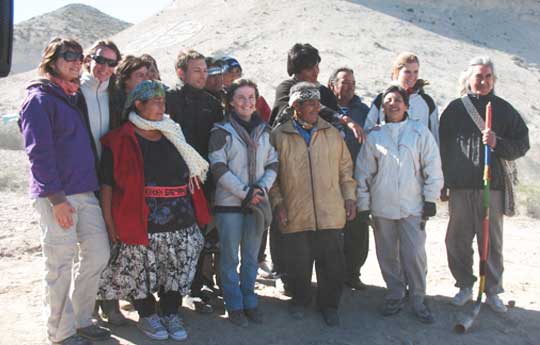CENPAT
When science helps reconstruct the history of Native communities
CONICET researchers analysed skeletal remains and different materials of cultural heritage from native communities of the Patagonia.
(For Spanish version, click here)
The Secretary of Culture of the province of Chubut has restored human remains, objects and funerary trousseau found at Loma Torta Hill to the Ceferino Namuncurá-Valentin Saygüeque community in the region of Gaiman, in the same province. These remains were studied by a group of anthropologists, archaeologists and biologists from CONICET.
“After intensive fieldwork and studies conducted in the laboratory, it was demonstrated that 13 individuals – two of them dated from between 300 and 350 years ago- were buried in that area” explains Julieta Gómez Otero, anthropologist and independent researcher at the Patagonic National Center (CENPAT-CONICET).
The study started in 2006 when a Gaiman neighbour delivered chipped bones that she had found in the Loma Torta Hill to the CENPAT.
Gómez Otero states that it was difficult to conduct the investigation since the remains were in bad conditions, as the place where they were found was used as enduro tracks. “The area was anthropically altered, and the samples were fragmented. The remains were disseminated due to the motorbike racing and for this reason it was necessary to remove them and avoid further damage”, she comments.
After almost five years of scientific research, on April 11th, members of Ceferino Namuncurá-Valentín Saygüeque community transported the remains from the CENPAT to the place of origin. All the analysed biologic material, including the skeletal remains that could not be identified, was restored.
Afterwards, native community representatives of the province of Chubut took the remains to the highest part of the Loma Torta Hill where they were buried by the scientists in a traditional ceremony with native peoples’ traditional music and chants.
“From our disciplines we preserve and study this cultural heritage in order to learn about it, and especially to socialize that knowledge with the community. Thus, we contribute to the collective memory and the identity of a community that has been historically invisibilized”, the researcher remarks.
Ricardo Romero Saygüeque is the Huerquén of the community, that is to say, its messenger and coordinator. “It was a historic claim that ensures the continuity of our culture”, he affirms.
Furthermore, he highlights the importance of the bond with scientists and the research conducted at Loma Torta Hill. “The relationship between scientific and our ancient knowledge has begun to yield initial results, but it can still be improved”, Romero stresses.
The remains found in Loma Torta include complete or fragmented bones and cultural objects such as stone artifacts, small beads carved in mollusc shells and in small pebbles, as well as a bronze or copper disc of about three centimetres in diameter. From the studies conducted in the laboratory, different information can be obtained from these objects, such as these peoples’ lifestyles and habits, and, when skulls or pelvis were found, researchers were able to determine the individuals’ sex, age at the moment of death and other health and food indicators.
According to Gomez Otero, these cultural materials indicate that these people were experts at producing the above mentioned beads. Besides, the metal discs could demonstrate that this community related to other communities, in some cases northeast the Patagonian area or across the Andes, to exchange goods or relate with them.
Silvia Dahinten, bioanthropologist and independent researcher at CENPAT, explains that it was possible to determine de age of two individuals using carbon dating techniques. According to results, one died 300 years ago while the second died 350 years ago. Their estimated height was of 1.77 and 1.62 meters height. Nevertheless, from the remaining eleven individuals it was not possible to obtain more information since the samples were incomplete.
Among these fragmentary remains, it was possible to distinguish six kids under 5 years and even a 25 weeks’ gestation fetus, which suggests its mother’s presence among the rest of the bones.
“From the skeletal remains we could infer that this community was hunter- gatherer and they had a high level of physical activity. Also, according to paleopathological studies, they did not suffer from food stress and therefore they were very healthy”, the bioanthropologist affirms.
Dahinten comments that the restoration to a community is a groundbreaking decision that sets a precedent for future investigations. “For us, it is very important to have contributed to the Mapuche-Tehuelche culture by providing scientific information that could allow them to reconstruct their culture” she concludes.
Furthermore, the CENPAT administration participated in the coordination of the rescue activities, research and restitution alongside the Secretary of Culture of the province of Chubut, which is the authority responsible for the implementation of province legislation in terms of archaeological, anthropological, and paleontological heritage, the Provincial Department of Indigenous affairs and the Ceferino Namuncurá-Valentin Saygüeque community. According to the researchers, this experience is an example of inter-institutional cooperation, historical reparation and sincere, solid and honest approach between the Science sector and Native communities.
- By Lucila Espósito and Alejandro Cannizzaro.
- About investigation:
- Julieta Gómez Otero. Independent researcher. CENPAT.
- Silvia Dahinten. Independent researcher. CENPAT.
- Eduardo Moreno. Associate researcher. CENPAT.
- Nilda Weiler. Associate researcher. CENPAT.
- Paula Novellino. Associate researcher. “J. Cornelio Moyano” Museum of Natural and Anthropological Sciences.
- Roberdo Taylor. Associate professional. CENPAT.
- Haydée Palleres. Associate professional. CENPAT.
- Ana Armani. Doctoral fellow. CENPAT.
- Anahí Banegas. Doctoral fellow. CENPAT.
- Ariadna Svoboda. Doctoral fellow. CENPAT.
- Verónica Schuster. CENPAT.
- Gabriela Millán. CENPAT.
- Soledad Goye. CENPAT.
- Mariano Reyes. CENPAT
